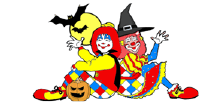Although coming across a bizarre individual like a clown for the first time should freak anyone out, infants have not had sufficient time to learn or develop a fear of clowns. Indeed, after some visits, many parents informed us that their baby had just experienced their first clown and it was a pleasant event. It is possible for things to go smoothly if the child is approached in the proper manner:
'The clown must pay close attention to a child’s (or even adult’s) facial expressions and body language. Generalized tension or a sudden negative change is a clear “do not approach” message. If there is cautious curiosity, distance clowning is advised.' “The Hospital Face” 8/3/18 post - Lucy E. Nunez
With infants, it can be kept simple. One of the first things a clown supervisor told me when I started was to always have something visual for babies. Once the approach and an acceptable distance have been established, clowns can sing gently for babies; one can play a quiet instrument, while the other can slowly wave something shiny (I always used a mylar pom pom from a dollar store) or blow bubbles. Let me take this opportunity to say that I do not approve of blowing bubbles in a hospital with one’s mouth; this spreads germs. I always use a little bubble machine shaped like Hello Kitty and tell the parents I’m giving the child a “cat scan”. But over-bubbling can cause a soapy mess, so less is best.
Possible visual aids: bubbles, mylar pom pom, bright streamer, puppets
Fun moments:
One evening in the Emergency Department waiting room, we successfully calmed a crying baby with a song and I waved the shiny pom pom. The father quietly asked me where I got that "miracle worker" and I whispered “A dollar store; two for a dollar!”
There was a visit in a baby’s room where my supervisor was playing gentle arpeggios on his ukulele. I wasn’t sure what song he would sing, so I waited. He started what sounded like a lullabye, but with these words: “...because I’m all about that base, ‘bout that base, no treble...”!
 Lucy E. Nunez has been a theatrical performer since 2002 and an improv performer since 2003. She created Nurse Lulu for the Big Apple Circus Clown Care program in 2014. For more information please visit: www.sunnybearbuds.wix.com/buds
Lucy E. Nunez has been a theatrical performer since 2002 and an improv performer since 2003. She created Nurse Lulu for the Big Apple Circus Clown Care program in 2014. For more information please visit: www.sunnybearbuds.wix.com/buds
